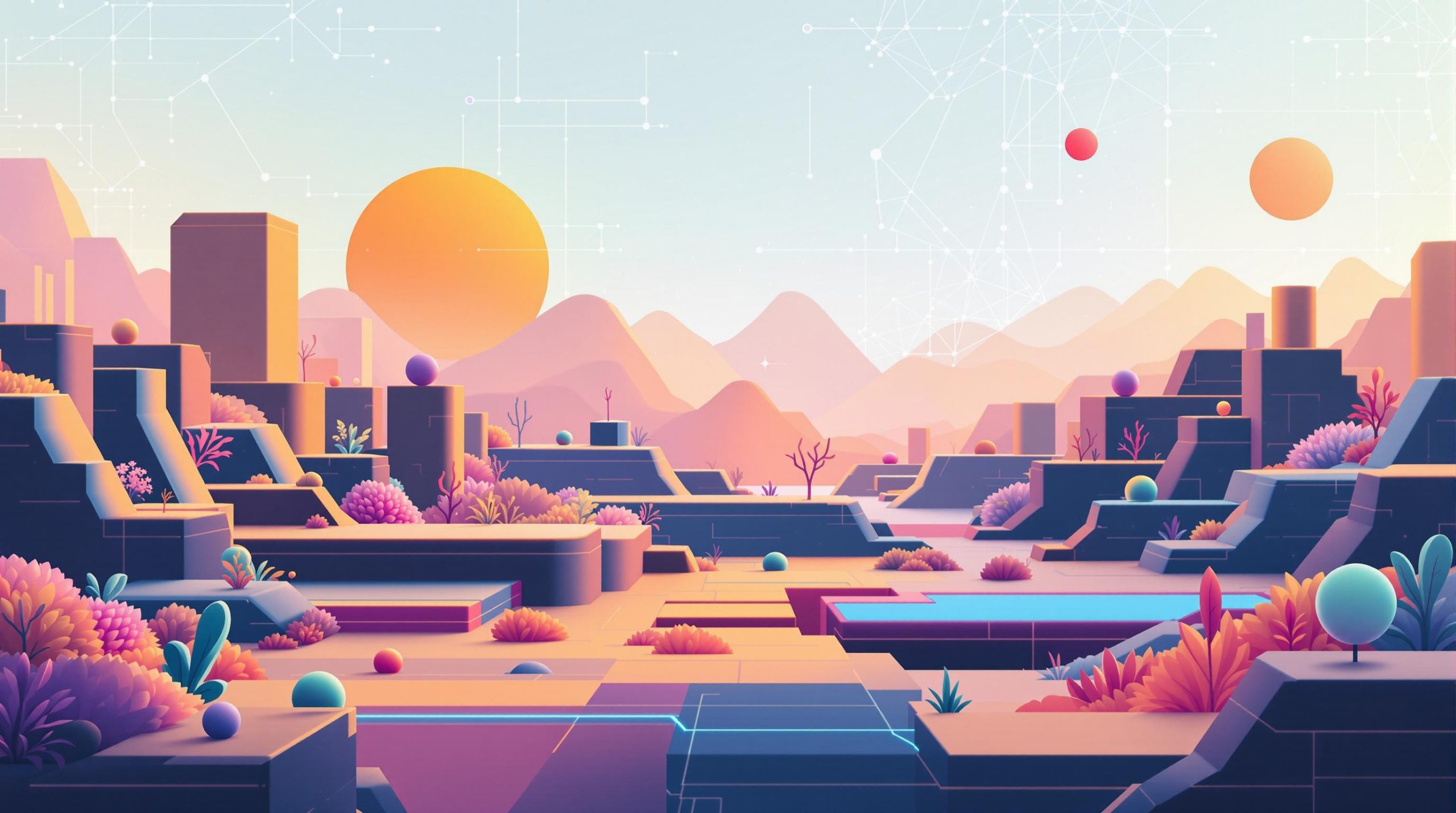Neural networks are transforming game level design by creating levels that are diverse, engaging, and even tailored to individual players in real time. Here’s how they work and why they matter:
- Learn from existing designs: Neural networks analyze existing game levels to generate new ones that match the style and gameplay mechanics.
- Real-time level generation: Some systems, like rhythm-based games, adapt levels dynamically based on player performance.
- Combine features from different games: Tools like Variational Autoencoders (VAEs) merge elements from different games to create unique experiences.
- Strengths: Faster development, personalized gameplay, and improved replayability.
- Weaknesses: High resource demands, inconsistent quality, and limited control over output.
Neural networks are reshaping game development, but they still require a mix of automation and human input to ensure quality and creativity.
Related video from YouTube
Methods for Using Neural Networks in Level Design
Neural networks are reshaping how levels are designed in games, offering new ways to boost creativity and keep players engaged. Here’s a look at how they’re being used across different approaches.
Training Models with Existing Levels
The team behind Fantasy Raiders found a clever way to train neural networks with limited data. Starting with a dataset of 1,000 levels, they expanded it to 6,000 by using techniques like rotating level layouts and swapping out NPCs [4]. This approach highlights how developers can stretch their resources to build training models capable of generating a wide variety of playable content.
While training on existing levels sets the stage, real-time generation takes things a step further by tailoring the experience to the player as they play.
Generating Levels During Gameplay
Creating levels on the fly adds a whole new layer of interactivity. A great example is the Dance Dance Gradation (DDG) project, which uses Long Short-Term Memory (LSTM) networks to generate rhythm-based levels that match a player’s performance [5]. This system adjusts difficulty in real time, offering challenges that feel personalized and keeping players hooked.
But neural networks don’t stop at generating levels – they can also merge ideas from different games to craft something entirely new.
Combining Features from Different Games
Variational Autoencoders (VAEs) are making it easier to mix elements from multiple games [1]. Techniques like Latent Space Illumination allow for a wide range of generated content while keeping things cohesive, as shown in research by Fontaine et al. [5]. Meanwhile, Generative Adversarial Networks help maintain balance in 2D platformer levels [3]. VAEs also make it possible to seamlessly combine gameplay mechanics from different titles, opening up fresh possibilities for game design.
These methods highlight how neural networks are transforming level design – from generating unique levels to adapting in real time and blending features across games. The result? A new era of creativity and interactivity in game development.
sbb-itb-5392f3d
Strengths and Weaknesses of Neural Network-Based Level Design
Strengths: Diversity, Replayability, and Development Efficiency
Neural networks can produce a wide range of levels, keeping players engaged and speeding up the development process. For example, research on Super Mario Bros. level generation showed that recurrent neural networks could create levels with a variety and style comparable to the original game designs [2].
These tools allow developers to simulate different gameplay scenarios using minimal datasets, simplifying the creative process. Another major perk is dynamic difficulty adjustment. Neural networks can analyze player performance and generate levels tailored to their skill level, making the gaming experience feel more personalized. This ability to match challenges to player skills helps maintain interest and motivation.
While these advantages are promising, developers must address some hurdles to fully tap into the potential of neural networks for level design.
Weaknesses: Complexity, Resource Demands, and Limited Control
Despite their benefits, implementing neural networks comes with significant challenges. Training these systems often requires hefty computational resources, which can be a tough barrier for smaller development teams.
| Challenge | Impact | Potential Solution |
|---|---|---|
| Computational Power | High processing demands | Use of cloud computing services |
| Quality Control | Inconsistent level generation | Human oversight and validation |
Another issue is the complexity involved in training these networks. For instance, a study using GANs successfully generated balanced 2D platformer levels, but it required meticulous training on 300 carefully selected levels [3].
Control over the output is another sticking point. While neural networks excel at generating variety, they sometimes produce levels that don’t align with specific design goals or gameplay needs. This means developers often need to step in for quality checks, which can reduce some of the time-saving benefits.
Ultimately, ensuring consistent quality in generated levels requires a mix of automation and human input to strike the right balance between efficiency and playability.
What’s Next for Neural Networks in Gaming?
AI for Open-Ended Gameplay
Neural networks are transforming how games create dynamic, player-responsive worlds that shift and grow based on individual actions and preferences. Unlike older procedural generation techniques, this technology adjusts content in real time, making the experience feel more personal and engaging. For example, studies reveal that neural networks can generate terrain, structures, and resources on demand – think of Minecraft’s procedural generation, but with a more advanced and real-time twist [2].
Dynamic difficulty adjustment also benefits from neural networks. By analyzing player behavior, AI can tweak not only challenges but also the environment and objectives to better suit how someone plays.
These advancements in open-ended gameplay are just the beginning. When combined with language models, the possibilities for interactive storytelling and gameplay expand even further.
Combining Neural Networks with Language Models
The pairing of neural networks with language models is pushing gaming into new territory. Together, they enable features like:
| Feature | Current Capability | Future Potential |
|---|---|---|
| NPC Interactions | Basic dialogue trees | Dynamic, player-driven conversations |
| Story Generation | Pre-written narratives | Branching, procedurally generated stories |
| Level Design | Pre-designed levels | Environments shaped by narrative context |
Looking ahead, neural networks and large language models (LLMs) could work together to craft stories that adapt in real time to player decisions. This would blur the lines between gameplay and storytelling, creating a more seamless and engaging experience.
Even with these advancements, the human touch remains crucial. AI might handle complex tasks, but it’s human creativity that ensures the final product connects with players.
Balancing Automation with Human Input
The future of game design isn’t about replacing humans with AI – it’s about collaboration. Neural networks can handle tasks like generating initial level designs, but human designers refine and personalize these creations [3]. This partnership ensures quality and preserves the intended design vision while benefiting from the efficiency AI offers.
One example comes from Sharif University of Technology, where researchers used GANs to create 2D platformer levels while adhering to specific design rules and gameplay needs [3]. The AI successfully produced balanced levels, allowing human designers to focus on the bigger creative picture. This mix of automation and human input is shaping the next wave of game design.
Conclusion: The Role of Neural Networks in Game Design
Neural networks are changing the way game levels are designed by creating diverse and engaging environments. Tools like LSTMs and GANs are proving their ability to generate levels that combine imaginative designs with consistent gameplay mechanics [1][2].
By studying level layouts and gameplay rules, neural networks can create content that reflects the original style while introducing new twists, helping to keep players interested over time [2]. This approach ensures that levels remain balanced and fair, enhancing the overall gaming experience.
| Aspect | Current Achievement | Future Potential |
|---|---|---|
| Level Generation | Procedural content creation | Real-time, adaptable environments |
| Development Speed | Faster iteration and testing | Fully automated workflows |
| Player Experience | Improved replayability | Personalized, dynamic gameplay |
GANs, in particular, have shown they can produce levels that meet design requirements while maintaining balance, allowing developers to focus more on refining creative elements [3]. With methods like LSTMs and GANs, neural networks are closing the gap between automated processes and creative input, pushing procedural generation to new heights.
As these technologies advance, they hold the potential to reshape gaming by opening up new possibilities for creativity and player interaction. The future of gaming is set to become even more dynamic and immersive.

